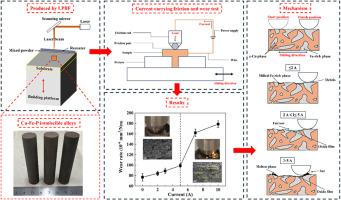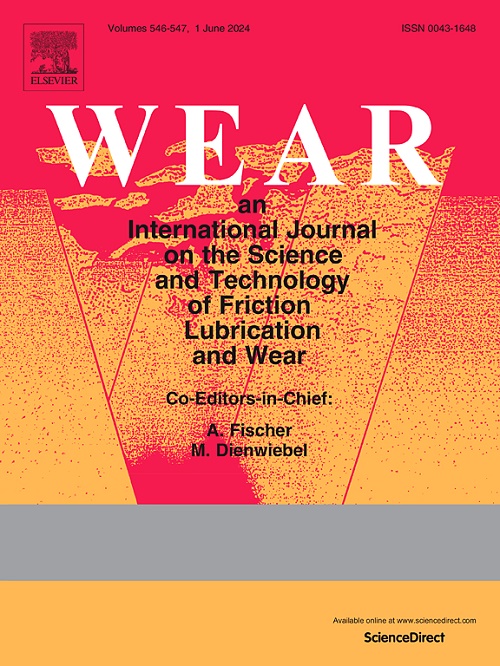Effect of current on the tribological behavior of Cu-Fe-P immiscible alloy produced by laser powder bed fusion
IF 6.1
1区 工程技术
Q1 ENGINEERING, MECHANICAL
引用次数: 0
Abstract
Cu-based immiscible alloys have significant potential application value in the field of electrical contacts. This study investigated the tribological behavior of Cu-Fe-P immiscible alloys produced via laser powder bed fusion (LPBF) under current-carrying conditions. The alloys consist of softer ε-Cu phase and harder Fe-rich phases. The Fe-rich phase acts as a protective reinforcement during current-carrying friction and wear tests, improving the wear resistance of the alloy. With the increasing current, the coefficient of friction initially rose and then decreased, whereas the wear rate showed a gradual increase. At low currents (0, 2, 3 and 5 A), mechanical wear predominantly governs the wear mechanism. As the current increases, the mechanical wear gradually transitions from adhesive wear to abrasive wear, accompanied by weak oxidative wear. At higher currents (7 A and 10 A), the wear mechanism is dominated by arc erosion wear and oxidative wear. Notably, when the current exceeded 2 A, an oxide film consisting of CuO, Fe2O3, and Fe3O4 formed, enhancing the frictional properties of the alloy. Once the current surpassed 5 A, the arc discharge occurred at high currents, forming molten phases and arc erosion pits on the worn surface of the Cu-Fe-P immiscible alloy.

电流对激光粉末床熔化生产的铜-铁-磷不溶性合金摩擦学行为的影响
铜基不相溶合金在电接触领域具有重要的潜在应用价值。本研究调查了在载流条件下通过激光粉末床熔融(LPBF)生产的铜-铁-磷不溶合金的摩擦学行为。合金由较软的ε-Cu相和较硬的富Fe相组成。在载流摩擦和磨损试验中,富铁相起到了保护性强化作用,提高了合金的耐磨性。随着电流的增加,摩擦系数先上升后下降,而磨损率则逐渐增加。在低电流(0、2、3 和 5 A)条件下,磨损机制主要是机械磨损。随着电流的增加,机械磨损逐渐从粘着磨损过渡到磨料磨损,并伴有微弱的氧化磨损。在更大的电流(7 A 和 10 A)下,磨损机制主要是电弧侵蚀磨损和氧化磨损。值得注意的是,当电流超过 2 A 时,由 CuO、Fe2O3 和 Fe3O4 组成的氧化膜形成,增强了合金的摩擦性能。当电流超过 5 A 时,电弧在高电流下放电,在 Cu-Fe-P 不相溶合金的磨损表面形成熔融相和电弧侵蚀坑。
本文章由计算机程序翻译,如有差异,请以英文原文为准。
求助全文
约1分钟内获得全文
求助全文
来源期刊

Wear
工程技术-材料科学:综合
CiteScore
8.80
自引率
8.00%
发文量
280
审稿时长
47 days
期刊介绍:
Wear journal is dedicated to the advancement of basic and applied knowledge concerning the nature of wear of materials. Broadly, topics of interest range from development of fundamental understanding of the mechanisms of wear to innovative solutions to practical engineering problems. Authors of experimental studies are expected to comment on the repeatability of the data, and whenever possible, conduct multiple measurements under similar testing conditions. Further, Wear embraces the highest standards of professional ethics, and the detection of matching content, either in written or graphical form, from other publications by the current authors or by others, may result in rejection.
 求助内容:
求助内容: 应助结果提醒方式:
应助结果提醒方式:


